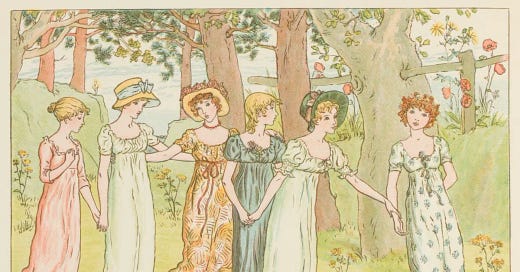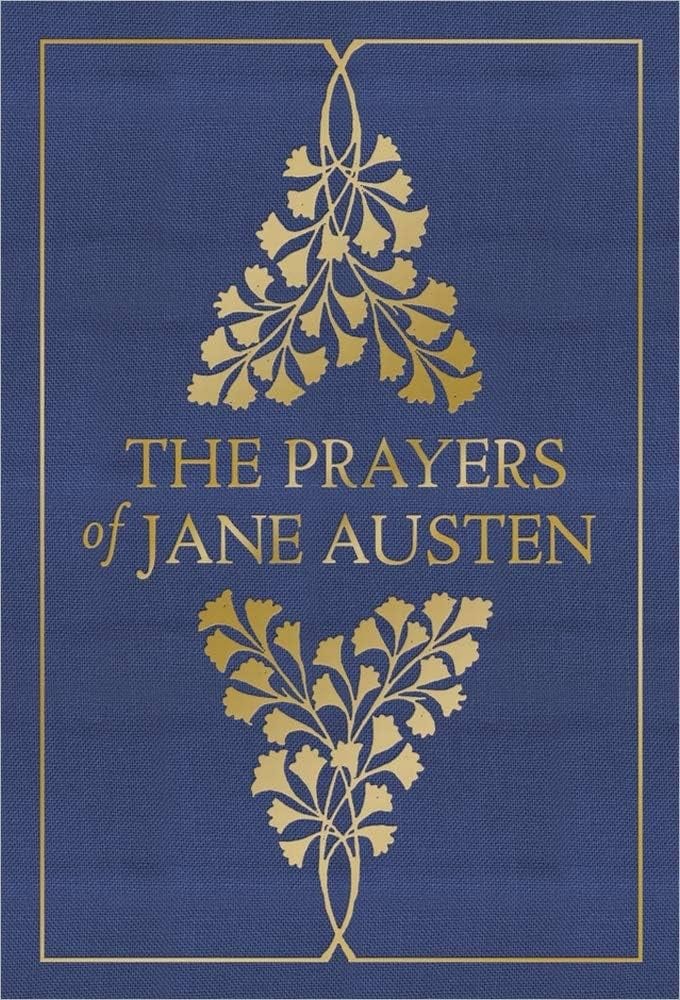After reading Dominika’s “A Child’s List of Prerequisite Reading for Tolkien” at her lovely publication Gathering Light, I was inspired to finalize my list of resources to invite children into the world of Jane Austen. (Many thanks for letting me borrow the title.) Plenty of these books are from my own childhood, but many were later discoveries—or were, alas, published after I grew up. Here at Mirrored Longings we attend to “the improvement of [our] mind[s] by extensive reading,” and it’s never too early to begin.
Kate Greenaway
Kate Greenaway (1846-1901) romanticized Austen’s era in her children’s books. Greenaway’s illustrations were not set in her own time period, but in Austen’s—spot the frilled caps and empire waists! (Greenaway sewed her models’ garments.) A childhood spent with Greenaway’s illustrations will train young eyes to recognize the material world of Austen’s heroines (if not to identify quality muslin with the expertise of Henry Tilney). My favorites are A Apple Pie, Marigold Garden, and The Pied Piper of Hamelin (text by Robert Browning).
Poetry
Susan Allen Ford’s marvelous work of literary criticism, What Jane Austen’s Characters Read (and Why), demonstrates how much reading affects the plot and shapes the characters of Austen’s novels. Austen lived in the Romantic Era, and popular poetry figures significantly in Persuasion and Sense and Sensibility. Reading poetry from a young age invites readers into a lifelong delight in the English language. Children’s poetry books, like Effie Lee Newsome’s Gladiola Garden, Tomie dePaola’s Book of Poems, and Robert Louis Stevenson’s A Child’s Garden of Verses, can open the exquisite world of poetry to young readers. Marianne Dashwood would request that the reading aloud be lively, not done with “impenetrable calmness [or] dreadful indifference.”
Up a Road Slowly by Irene Hunt
Irene Hunt’s novel Up a Road Slowly received the 1966 Newbery Medal. Young Julie, bereft of her mother, is sent to live with austere Aunt Cordelia in the countryside. The aforementioned Susan Allen Ford named Aunt Cordelia’s love for Jane Austen as her inspiration for reading Austen for the first time. Aunt Cordelia was one of my many inspirations to read Austen, too. Readers will see shades of Elizabeth Bennet, Marianne Dashwood, and other Austen heroines in the bright, passionate, studious Julie, whose literary aspirations rival Jo March’s or Betsy Ray’s. Another middle-grade novel that shows an adult loving Austen is The Bookwanderers by Anna James, the first in a rollicking series.
An Old-Fashioned Girl by Louisa May Alcott
Alcott’s 1869-1870 novel, An Old-Fashioned Girl, which I profiled last month, shares much with Mansfield Park (there’s even a character named Fanny). The twist is our heroine, Polly Milton, whose “old-fashioned” values of hard work, community, and creativity prepare her for a “new-fangled” lifestyle of self-supported, independent living in Boston. Growing up with Polly prepared me to love Austen’s principled, loving heroines like Elinor Dashwood and Fanny Price.
Fairy Tales
All of Austen’s novels have an element of the fairy tale. Besides their “happily ever afters,” Austen’s characters fit fairy tale archetypes of princes, maidens, tricksters, tyrants, and more. Just ask Catherine Morland! I especially like picture book renditions illustrated by Kinuko Y. Craft (Cinderella), Laurel Long (The Lady and the Lion), Ruth Sanderson (The Twelve Dancing Princesses), and Paul O. Zelinsky (Rapunzel). The rainbow of collections by Andrew Lang, with H. J. Ford’s illustrations, are appropriate for middle-grade readers.
Noel Streatfeild
Like Austen, Streatfeild was a clergyman’s daughter (her father was briefly bishop of Lewes). Her children’s novels have little connection with Austen’s on the surface. Ballet Shoes, for example, centers on three orphaned girls aspiring to movie stardom, aviation, and ballet—hardly Austenian accomplishments. (Though had she ever learnt, she should have been a great proficient.) Yet, Streatfeild’s writing style, and her characters’ preoccupations with money, dress, and social pressure, are reminiscent of Austen. Noel Streatfeild’s novels introduce young readers to the same class in English society as Austen’s, if a century later, and are a doorway into English gentlewomen’s writing.
The Book of Common Prayer
Three heroes of Austen’s novels are or become clergymen (Edmund Bertram, Edward Ferrars, and Henry Tilney). Once we include Mr. Collins and Mr. Elton, Persuasion becomes the only major Austen novel lacking a significant clergyman (she squeezes in a clerical marriage anyway). Like the Brontë sisters, Elizabeth Goudge, Dorothy L. Sayers, Noel Streatfeild, and any number of English novelists born to clergymen, Austen’s life was shaped by Anglican worship. Though Austen rarely set scenes in churches, she expected her contemporary audience to know formation by the Book of Common Prayer, from Michaelmas to the hours of prayer to Fordyce’s Sermons. Praying with young readers in the way Austen did invites them into her inner life. Austen even wrote her own prayers that reveal Thomas Cranmer, translating the great tradition of corporate prayer into English, as one of her literary influences.
Resources about Jane Austen and Her Era
Finally, why not introduce young readers to the lady herself and her time period? Austen began writing as a child, and her adult work is for many the cultural icon of its time. To be fond of reading about Austen is a certain step towards falling in love with her work.
Ordinary, Extraordinary Jane Austen by Deborah Hopkinson and Qin Leng
A Most Clever Girl: How Jane Austen Discovered Her Voice by Jasmine Stirling and Vesper Stamper
The Usborne Complete Jane Austen by Anna Milbourne and Simona Bursi
Pride and Prejudice Seek & Find by Amanda Enright
Jane Austen Paper Dolls by Eileen Rudisill Miller
Empire Fashions Coloring Book by Tom Tierney
What books primed you to become an Austen reader? I look forward to seeing your selections below!









Oh I love this so much! I shamefully own no Kate Greenaway! I love the inclusion of the Book of Common Prayer and the suggestions for poetry. I think the issue that the complexity of language in older books poses for many people could be avoided if they were just read poetry as children. Brilliant list!
Very timely article, my daughter and I have been reading through several of the Anne Shirley series and we are moving on to Jane Austen next. These prerequisites will be helpful